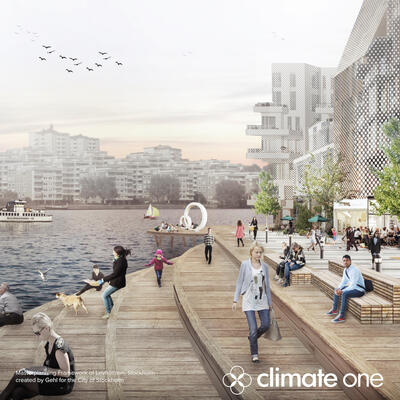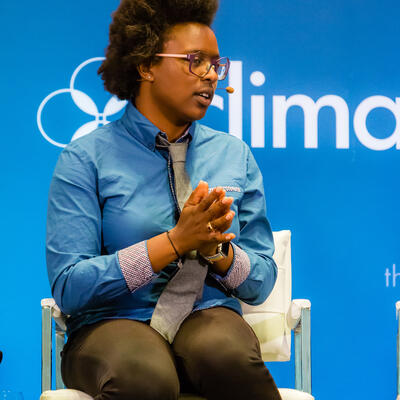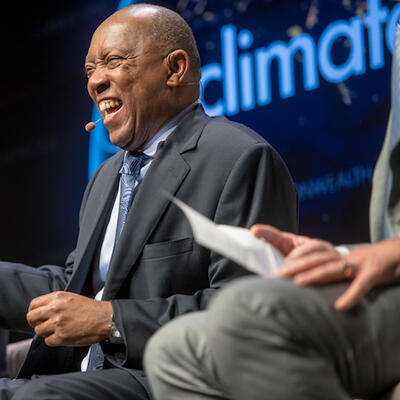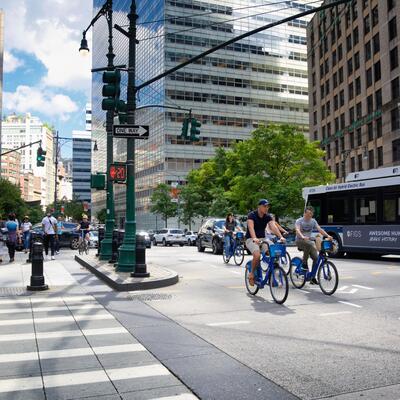
Just a Walk or Bike Ride Away: The 15-Minute City
Guests
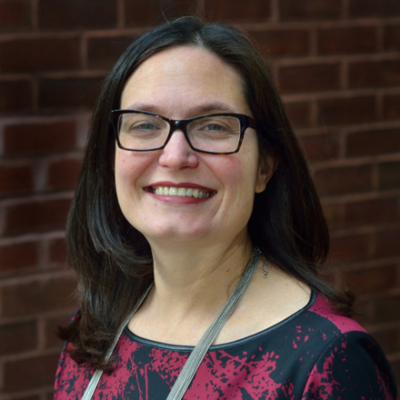
Beth Osborne
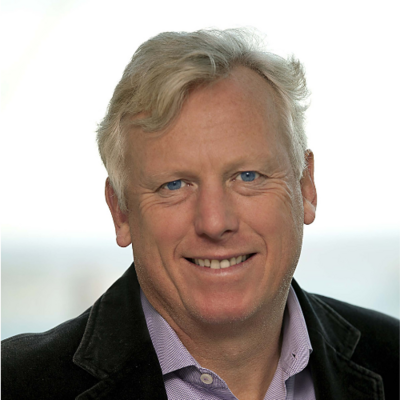
David Miller
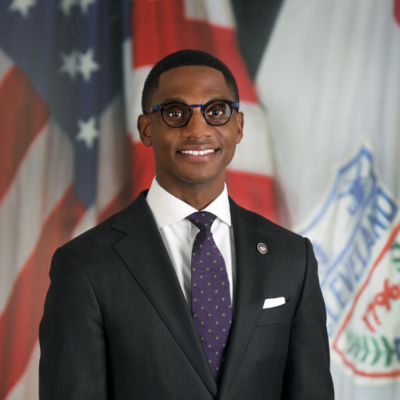
Justin Bibb

Henry Grabar
Summary
Can you imagine if everything you needed in your everyday life was just a walk or bike ride away? That’s the goal of the 15-minute City, a new name for an old idea. Reducing the need for cars cuts emissions and gets autos off of the roads, which is a boon for safety, air quality and the climate. But, as is often the case, good ideas become a lot more difficult when you have to implement them in real places, with real people, who don’t always share the enthusiasm for the idea. What will it take to make compact, walkable cities a reality in the U.S., where the car is king?
This episode is underwritten by ClimateWorks.
Episode Highlights
2:58 Henry Grabar on how parking became what we see today
5:37 Henry Grabar on the size and price of the average parking spot
8:52 Henry Grabar on how cities treat curbside parking
18:15 Henry Grabar on reclaiming parking lots
21:23 Beth Osborne on the Divided by Design report
25:49 Beth Osborne on the lack of rural transit systems
38:27 Beth Osborne on how electric vehicles influence the need for compact cities
43:01 Justin Bibb on why the 15-minute city is personally important to him
46:06 Justin Bibb on the implications of the 15-minute city on justice and equity
50:02 David Miller on how to address sprawl in places like Houston
58:02 David Miller on how leaders need to communicate with their constituents
Resources from this Episode (5)
Full Transcript
Note: Transcripts are generated using a combination of automated software and human transcribers and may contain errors. Please check the actual audio before quoting it.
Greg Dalton: This is Climate One. I’m Greg Dalton.
Ariana Brocious: And I’m Ariana Brocious.
Greg Dalton: We have a tendency to look toward new or future technology to solve today’s problems. But sometimes reverting to older, simpler ways of living can move us forward.
Ariana Brocious: this week we’re talking about one of those ideas: compact walkable cities. Some have dubbed the concept the 15-minute city.
Greg Dalton: It’s a new name for an old idea – that everything you need in day-to-day life should be within a 15 minute walk or bike ride.
Beth Osborne: It's unbelievably luxurious to not have to get in your car over and over for every single thing you need.
Greg Dalton: That’s Beth Osborne, Director of Transportation for America. We’ll hear more from her later in the episode.
Ariana Brocious: Reducing the need for cars cuts emissions and gets cars off the road. And that’s not only good for public health and the climate, it creates more equitable spaces as well.
David Miller: By doing the right thing for climate, which is encouraging public transport, encouraging these kinds of neighborhoods that are denser, you're also building a city where people from all walks of life have a real chance.
Ariana Brocious: That’s David Miller, Managing Director for C40 Centre for City Climate Policy and Economy, and Former Mayor of Toronto. We’ll hear my conversation with David later in the episode.
Greg Dalton: In the U.S. many of our urban areas were built with car as king, which makes it very difficult to achieve the 15-minute goal of walking or biking. Ariana, I’m curious how you get around in Tucson, where you live.
Ariana Brocious: You know, it’s a mix. There are plenty of places that I can walk to or bike to, because I live sort of in the center of town. But realistically, it’s a city built for cars, and to get to most places, you have to drive, and most people here rely on cars as their primary form of transportation. How about you, Greg?
Greg Dalton: Since COVID, I split my time between two places: San Francisco, highly walkable, lots of restaurants, services, grocery stores in a ten-minute walk. One day a week I ride my e-bike into the office. Other times I’m out in a rural area by choice, which is beautiful and bucolic and remote. And it’s at least 20 minutes in the car to go anywhere or do anything.
Ariana Brocious: That car dependence is really common, and yet this desire for more walkable, more bike-friendly cities is also really common. More than half of Americans surveyed by YouGov want a 15-minute city. So how can we develop our urban spaces to be more compact, walkable, and convenient?
This episode is underwritten by ClimateWorks
[music change]
Greg Dalton: To find out how to achieve the ideal of a 15-minute city, let's start with an unexpected yet crucial aspect of every place where people live: parking.
Ariana Brocious: It may not be something you spend a lot of time thinking about, but parking lots take up lots of space, and parking requirements can make building affordable housing nearly impossible. Henry Grabar is a Staff Writer for Slate and Author of Paved Paradise: How Parking Explains the World.
Henry Grabar: I think it goes back to the 1950s with suburbanization, right? At the time. Parking is a serious, serious challenge. In most American cities, parking meters are everywhere, and yet in spite of that, um, the rise of the automobile has collided with an urban environment that was not designed to accommodate automobiles. It's at this point that in the suburbs, developers of malls begin to offer free parking. Now, this at the time is, uh, sort of revelatory, not just because the parking is free, but also because it's ample. It's plentiful, right? I mean, we're talking about land uses where sometimes half the parcel is just used for parking. That kind of thing would never be feasible or affordable at the center of, you know, Detroit, Chicago, Los Angeles at that time. So these malls take off and uh, cities freak out. And they decide that free parking, if it's gonna be offered in the suburbs, needs to be their standard as well to be able to keep up. And so cities start ripping out their parking meters at the behest of local merchants and before you know it, it becomes pretty much the standard everywhere in the country that parking ought to be free.
Ariana Brocious: And what effect does that have on emissions?
Henry Grabar: Free parking is one of the greatest subsidies towards driving. Parking may be free to you, the user when you arrive in your car, but it's not free to build, right? I mean, it costs tens of thousands of dollars to build structured parking, surface parking costs, $5,000 per space. So the amount of subsidy that's embedded, all that free parking that's distributed to drivers as a hidden inducement to continue driving and to continue burning fossil fuels is enormous. We're talking about hundreds of billions of dollars of incentives to keep driving. Now, as you know, transportation is the country's largest source of greenhouse gas emissions. And so, um, to the extent that free parking is a massive subsidy for driving, it's a huge contributor to, um, to climate change And climate change is only a part of the externalities of driving, uh, as it concerns the environment, right? I mean, there's also local particulate pollution like PM 2.5 and PM 10. And then there's, there's also car crashes, obviously. And, and the tens of thousands of Americans who are killed are injured by automobiles every year.
Ariana Brocious: help us understand why there is this sort of feedback loop with parking requirements, um, and how housing and how that dictates what kinds of housing can be built, how much and what parts of town and how that, when, what that actually makes the cities begin to look and feel like.
Henry Grabar: There are two things to understand about parking that will help you see the way it interacts with architecture, uh, and with housing types, housing costs, and the types of apartments that get built. The first is that parking takes up a lot of space. The average parking spot, including ingress and egress, is sometimes calculated to be 250 or 300 square feet. So, two of those is the size of a studio or one bedroom apartment. So structured parking in, um, you know, a big, a big city could cost $40,000 a stall. Underground parking these days can cost six figures per parking space. So both of these factors –
Ariana Brocious: We should just pause there. That's enormous. That's crazy to think that it actually costs that much per parking space.
Henry Grabar: It's crazy. And it's really important because I think a lot of the time people see a parking shortage in their neighborhood and their reaction is, well, why don't they just build more parking? Why don't we just ask every new apartment building in this neighborhood to build a giant parking garage, solve the parking problem? Well, it turns out that that's really, really expensive and it contributes a lot to raising the cost of housing, and this is where. There is this interplay between parking and housing. If you require all this parking, you're adding a massive cost onto the new housing that gets built. So you're changing the price point at which those units eventually hit the market, but you're also dictating the form of that housing because the old style vernacular, so-called missing middle housing that characterized American residential neighborhoods in the 1910s, twenties, et cetera, that kind of housing – so that's like, uh, painted ladies in San Francisco or three flats in Chicago, triple Deckers in Boston, brownstones in New York – all this stuff becomes impossible to build when you require, uh, x amount of spaces per new unit. So requiring parking both then drives up the cost of housing, but also dictates the type of housing that gets built. And certain types of infill housing simply become impossible to produce.
Ariana Brocious: And that also, of course, as you're saying, that affects affordability, which means that, uh, the diversity of the neighborhood in many cases,because lower income or marginalized communities just simply cannot afford to be in some of these neighborhoods anymore.
Henry Grabar: That's right. One of the things that happens is that the type of housing that gets produced skews towards the high end because if you are requiring parking with every unit, you are just adding on a big fixed cost right at the start of the project. And if you are in charge of that development, all of a sudden you've just built in a pretty expensive amenity that's you are already aiming at a kind of higher segment of the market than you would be if you were free to choose what you wanted to build. It does tend to happen that, uh, housing without parking included, is a kind of naturally occurring source of affordable housing to the extent that it gives tenants, um, the option, uh, to find parking themselves if they so choose. And, and I think that's a, that's a beneficial situation. I mean, until I. 10 years ago, it was virtually impossible to move into a place, a newly built place in an American city where you had the option of not having a parking space included with your unit. We were basically forcing every single residential tenant or home buyer in the United States that they had to have a parking space. So just think about the effect on driving that that creates, I mean, it is just a massive down payment towards owning a car.
Ariana Brocious: And cars by themselves are expensive to own and maintain, so that's another cost. In big cities in particular, you say that we've done parking backwards, where curbside parking is often free and garages are very expensive. Why shouldn't it be that way?
Henry Grabar: Well, curbside parking is everybody's first choice, right? I mean, the curb is this immensely valuable point of access where you're both, this is kind of basic, but you're both adjacent to the road, right? So it's really easy to get to, but you're also adjacent to the sidewalk and to the stores and the restaurants, and the bars and all the things that you came to the city to do in the first place. Now, curbside parking is also often very, very cheap, if not free. If it's metered, it might cost a dollar or a dollar 50 an hour. Whereas a garage might cost, you know, 10, $12 an hour and sometimes more in big cities. Now, one of the results of that is that any driver who's driving downtown is not only incentivized to look first for curbside parking because that's the preferable choice, but also because it's the cheaper choice. And that should be backwards because what happens when, when every driver coming into town is financially incentivized to look for curbside parking is you get a huge amount of congestion from people circling the block, looking for these hard to find parking spaces. Now, if you were to raise the price curbside parking and lower the price of garage parking, then those prices would more accurately align with people's preferences for where they wanna park. People who are driving in who are, uh, more, uh, cost conscious budget consumers of parking spaces would head straight for the garage without even looking, uh, for curbside parking. And those who prioritize access, who have a busy appointment to get to or, or just absolutely need to be someplace at a certain time would, would head straight for the curb. And, and at the proper price, they would be able to find a spot the moment they arrived. Hmm.
Ariana Brocious: how does all this parking affect public transportation? Both the availability of it, where it can be built, and the use of it by, by people who live in cities.
Henry Grabar: Free parking is an absolute public transit killer. It is one of the number one determinants of whether people will drive. And everywhere we look at public transit, ridership statistics, whether people have free parking on one or the other end of their trip is a major determinant of whether they're going to use that transit system. So if you provide transit, but you also provide pre parking, you are dooming that transit system. To fail. Now, there's another thing that happens, which is that free parking and parking generally takes up a lot of space in the urban environment. And so the more parking you provide, the less walkable the neighborhood becomes. The lower the density of amenities, uh, the lower density of people. Um, and, and therefore the less useful public transit becomes. And I think we've all experienced that as well, where you look at some destination and it turns out to be out in some suburban strip mall, and maybe you could get within 300 meters, um, arriving by public transit, but then you'd have to walk through a sea of parking lots to get there. So there's at least two ways in which the provision of parking. Really works at, at counter purposes to having a vibrant and well-used public transit system. I think there are cases in cities where there are policy decisions to be taken that are win-win for everybody, but in terms of making public transit work,you really need to crack down on the amount of free parking that's available as an alternative.
Ariana Brocious: So I'm curious, you know, you're based in Paris in the moment, you're based in Paris at the moment. I'm wondering how that offers you a, if that offers you a chance to do a comparison here where, you know, is this obsession with parking a US phenomenon? Do you see it handled differently in a old established city like Paris?
Henry Grabar: I think French people and Europeans in general are just as obsessed with parking as Americans are. When you walk around Paris, one of the first things that you notice as a stranger is that every single sidewalk is lined about every eight feet with a three and a half foot tall iron bar. You think, what are these things? It turns out those are designed to stop people from parking on the sidewalks because if they weren't there, and presumably at one point they weren't, people would just park on absolutely every available square inch of space. And in fact, that was once the way people parked in Paris too. Most of people's, uh, most of these sort of iconic public spaces in Paris, Invalides the Place Vendome, the plaza in front of Notre Dame, all these spaces were once parking lots. Now they are beloved public spaces and the parking has been moved underground. So I don't think that Europeans have some innate resistance to car culture. I think they like driving, uh, just as much as Americans do. it's just that they are presented with a lot more options. And that's not just about the quality of the public transit, which admittedly. Is higher than it is in most American cities. But it's also about the fact that the neighborhoods are just designed to make it safe and easy to walk or bike. And that is irrespective of the question of whether people own cars or whether there even exists public transit. It's just a question of local level neighborhood design, and that I think is a lesson that's very applicable to American cities and even some American suburbs.
Ariana Brocious: If we're taking stock of what cities are doing now, we mentioned parking requirements. Where are we in this moment in terms of how that's being handled at city levels in the US? Are you seeing momentum toward a different kind of, of, um, of building a different kind of civic life and getting rid of some of this parking?
Henry Grabar: One of the most basic reforms has been to get rid of the laws that tell developers how much parking they must build with every single apartment building, tennis court, funeral home, whatever it is. That is a very basic step, but it's a very necessary step because what those laws have produced over their 60 plus year existence is both a cost and inflationary costs spiral with everything that gets built because parking costs a lot, um, but also a deterioration of the urban environment to create a lot of parking. Which study after study has shown, um, very rarely gets, uh, used to its full capacity. So, and that's because the laws intentionally err on the side of creating too much parking. To avoid, uh, any chance of a parking shortage. So undoing those laws is something that's happening right now. You know, there's this organization called the Parking Reform Network that is working on this exact thing, so that's the low hanging fruit. I think after that, the challenging thing is to say, what do we want to do with our streets? Because this is really where parking intersects with alternatives to driving, and I think this is one of the big questions people have is, well, okay, I live in a suburb. I have two cars. I need them to get to work. I'm not against the idea of driving less or being less reliant on parking. But I don't feel like I have a choice, and this is where cities need to step up and say, we're gonna redo these roads to make people feel comfortable, to make them feel safe. Riding an electrical bike, riding in a golf cart, walking, right? I mean, something as basic as walking, parking policy is a major impediment towards creating safe sidewalks, safe intersections, all this stuff.
Ariana Brocious: Just jumping back to this idea of paying for parking for a second, I think one thing that you write about in the book is that there's this sort of irony that cities make more in parking violations than they do in actually charging for like metered parking. So that being that as it is, What happens with all that money? How could that money be used to actually improve, uh, you know, the design of city streets to facilitate more walking and biking and, and public transit?
Henry Grabar: Donald Schoup, the godfather of parking studies, says that for people to accept the idea that parking meters are good for the city, um, it's not enough that they bring order to a congested curb where people have been leaving their cars for days at a time, parking meters. Also, he says, ought to provide revenue that goes into local public improvements, so that every time somebody pays into a public parking meter, or the merchants alongside, um, are convinced that they ought to approve public parking meters. That money gets funneled right back into the neighborhood and goes into those types of neighborhood improvements. Now, what could those be? I mean, frankly, the sky's the limit. We have been so accustomed to thinking of streets as being exclusively for the use of storing automobiles and also, uh, them driving through now and again, uh, that we've forgotten that they were once these very vibrant, multipurpose spaces. And so I think, well, I don't need to imagine it. Right. I mean, lots of cities are making these changes. And they are opening up streets for restaurant seating. They're building playgrounds, they're planting trees, they're, uh, closing down streets, traffic outside schools, um, creating more public space, greener public space. All these things are on the table and, and more, I mean, if you, you could even think about, uh, in places that are really challenged for, um, for housing, whether some of this roadway space, uh, might not be better served, uh, by, by, by converting it into parcels that could be developed as affordable housing or something like that.
Ariana Brocious: So I have sort of a particular question I live in, in Tucson, which is a city thatas a lot of sprawl, has a ton of parking, a lot of seas of asphalt. Um, and there's one in particular that I see sometimes that I go, there's a big chain of big box stores and there's a section of this parking lot that I swear never gets used. I mean, I think it's probably, um, there's just never enough traffic in this strip of commerce to require it. Have you seen areas like that be reclaimed either by the neighborhood to build a house there or make a little park? I mean, are there good examples of, um, reexamining some of these places that just even aren't even used and, and making something. You know, better out of it?
Henry Grabar: I mean, the most basic one that comes to mind is, you know, I grew up in New York City, which used to be full of parking lots in the 1970s and eighties, and they've almost all since been redeveloped. Now I think that's beginning to happen in the suburbs as well. I. In particular with old malls, right? Because with old malls you have both a giant parking lot, but also a parcel that's so large that it actually offers, offers an opportunity to create almost a, a complete little neighborhood unit where you might even be able to support a little bit of community oriented retail or an amenity, like a public pool or a library of school or something like that. So I think there's an enormous amount of potential there. One of the things that stops us from happening is neighbors are very, very reluctant to see anything take the place of parking. They're convinced that they suffer from a shortage of parking, and no amount of study seems to correct this interpretation, and unfortunately, it serves as an obstacle even to, um, letting new neighbors move into the neighborhood. I see this all the time at community meetings in the United States where a new apartment building gets proposed and neighbors will stand up and say, we can't allow this because it doesn't have enough parking. I mean, I understand that everybody wants enough parking and that this is an important priority, but are we really gonna let it stand in the way of creating housing for our fellow neighbors?
Ariana Brocious: Henry Grabar is a staff writer at Slate and author of Paved Paradise, how Parking Explains the World. Thanks so much for joining us on Climate One.
Henry Grabar: Thanks for having me.
Greg Dalton: You’re listening to a Climate One conversation about compact cities. If you missed a previous episode, or want to hear more of Climate One’s empowering conversations, subscribe to our podcast wherever you get your pods.
Please help us get people talking more about climate by giving us a rating or review. You can do it right now on your device. You can also help by sending a link to this episode to a friend. On our new website you can create and share playlists focused on topics including food, energy, EVs, activism.
Coming up, how might we rein in urban sprawl and redevelop neighborhoods to be more compact?
Beth Osborne: We’re the nation that reversed rivers. The notion that we can’t take down a highway and figure out a way to redesign that community is silly.
Greg Dalton: That’s up next, when Climate One continues.
This is Climate One. I’m Greg Dalton
In the US, transportation accounts for more climate-disrupting pollution than any other sector, so the 15-minute city could be a huge climate lever – and offer quality of life improvements too.
Ariana Brocious: And if enough people shifted their mode of transport, it would be safer for everyone – because pedestrian and bike deaths already make up nearly 20 percent of annual traffic fatalities, and those figures have been rising.
Moving at the pace of your feet or a bike offers so many benefits – low impact exercise, neighborhood connection, better air quality.
Greg Dalton: Walking really is great. To better understand how we could improve the ways we get around our cities, I spoke with Beth Osborne, Director of Transportation for America.
Beth Osborne: We actually just released a report called Divided by Design that talked about the building of the highway system and how so much of it was built through the center of cities, which is not how it was initially conceived. And often was done in an effort to connect new suburbanites to downtown retail centers that might be struggling. But also, too many leaders thought it might be a great opportunity to clear black and brown neighborhoods while they were at it. And they very effectively did so and were quoted in explaining their goals there. And in doing so, it cut off short trips. So many of these highways, and even the big roads those of us in transportation call arterial roadways, but most people just think of them as those big roads that connect neighborhoods, those often 5, 6-lane surface roads. They create massive barriers so that just crossing the street is a challenge. And we cut off the ability to simply cross the street in order to get people from outside your community through your community to some other community as fast as possible so that the transportation infrastructure is not facilitating movement for you in your neighborhood. But for someone else to get somewhere else. Not great for your neighborhood's economy if you have a local business trip. But your neighborhood is not what’s being valued. It's always someone someplace else going someplace else. The place is unfortunately never the priority in the way we approach transportation. And as a result, even what should be a short trip. A block across that big highway or roadway is a huge trip to go out of the way to find a safe place to cross if there's a place to cross at all. And therefore, what used to be an easy walking trip is now a driving trip.
Greg Dalton: That report Divided by Design was quite powerful, particularly looking at the visualization of how I-20 really paved over neighborhoods and green belts in Atlanta I know that story, but actually seeing it unfold was quite powerful. There's a call recently to take down I-45. There’s Adam Paul Susaneck, architectural designer and the founder of Segregation by Design wrote a piece at the New York Times saying Mr. Biden, tear down this highway speaking of I-45 what separates Black and White and White and Hispanic communities. So we’re taking down dams in this country that are at the end of their useful life. We built these freeways through cities, can they come down is that too far-fetched of an idea?
Beth Osborne: Well, we’re the nation that reversed rivers. The notion that we can’t take down a highway and figure out a way to redesign that community is silly. Of course, we can do anything we want. Unfortunately, we often used our skill and our engineering know-how to do things that aren't so great as opposed to figuring out clever ways to repair damage we've done in the past. We are in a point of incredible change right now post COVID. People are changing their work habits. They are changing their travel habits. And we should take advantage of that to think about whether or not we still need what people thought was a great idea back in the 1940s, 50s, 60s, 70s. In many cases turned out to be pretty damaging and maybe revision how we want that community to work. Do we want it to be available to move people in trucks through the city or to generate jobs and housing and taxes and an economy? And that's the trade-off when you cover a vast landscape with interchanges and highway is that land is not available to create a robust economy.
Greg Dalton: Right. And there’s some talk of taking down an elevated highway in San Francisco and all the tax revenue the city would get if there were buildings rather than highways which cost money rather than generate money if they were, you know, shops and restaurants paying property tax. Your report also mentions that there are 28 million Americans that do not have access to a car. These are not just people in urban areas. Majority of counties with zero car households are in rural areas. What does that tell us about changes we need to the transit systems?
Beth Osborne: I think a lot of what we need to do is check some of our assumptions at the door. The notion that it's only urbanites that need alternatives is really dismissive of the rural population. Unfortunately, I think a lot of people who consider themselves rural champions know very little about rural areas and don't think very hard about those rural towns and those places that have often been abandoned by the very policies put in place supposedly to benefit them. And I also think it's an undercounting of those who desperately need alternatives to the car. You don't have to be a household without a car to not have access to a car. If you're a family of five and you have one car, you need alternatives. You don't have what some people fortunately have. They might have a parent in the household that can chauffeur the kids all around the region all day long and don't have, you know, a job to go to, or something like that. But most people don't have that and most families of 4 or 5 don’t have 4 or 5 cars. So we need alternatives for car light households and for maybe households that want to go car light because, like mine, who had four cars for a family of five maybe would like to translate that money into savings for college, as opposed to the cost of maintaining all those vehicles just to address your everyday needs. Now in terms of transit, one of the big mistakes we made with transits at the beginning of the transit program is that we viewed it as a benefit to the driver. The goal was to take people off the highways during the white-collar commute.
Greg Dalton: Get people out of my way. You take a bus so I can drive freely. Thank you.
Beth Osborne: Exactly. That's how we justified it because the notion that the Fed should be involved in transit has always been harder to sell when the Feds involved in building out the roads and the highways. And the work trip was only 20% of trips before COVID. Those other 80% of trips are really what turns a no car household into a household that needs to have 1, 2, 3, 4, 5 cars. Because it’s those trips to everything else that aren't served by transit that could be walkable or bikeable except for the roadways are so disconnected and busy and fast that they're too scary or too hard to walk on. And so, you know, you might be able to get to work on the bus, but you can't then pick your kid up from school and go to the grocery and run past the shoe store because your kid unexpectedly grew out of their size 6 shoes and are suddenly a size 8 like my son just went through. And those are the things not served by transit. Post-COVID, we had even fewer people making the commute into work during rush hour, which is the traffic congestion we use to justify most of our highway building. And it might be time to, A, reconsider whether we need all those capacities on those highways if fewer people are going to be using it during the busiest time or it’s not going to be that busy a time. But also, how to get transit to serve all of those other trips those more local neighborhood trips. I think about, you know, like I said we build our roadways to get people from someplace else through your neighborhood to someplace else. Our transit operates the same way. It's all about that longer distance commute and not just making easy to hop on that bus that just comes around regularly and goes through all the retail areas in your neighborhood so it's easy to go to the grocery for that quick trip and not a big event to do that or a dangerous trip or one you need to bum a ride off of a friend.
Greg Dalton: The Bipartisan Infrastructure Law could have been an opportunity to reset the agenda but still billions went to highways. 39 billion tag for public transit and 110 billion highways, roads and bridges. How is that going to play out and how is that going to affect compact walkable cities?
Beth Osborne: Yeah, it’s a really good question. If you look at the safety record of roadways it tends to be those state-owned arterial roadways where the most fatalities occur. Those are the ones where you combine high speed with lots of points of conflict. Those parked cars on the side of the road everyone is a point of conflict. Every crossing every entrance to a business driveway, a parking lot. Every crossroad is a point of conflict. And we're zipping people through these communities at 40, 45, 50, 55 mph and then we don't have any idea why they're dangerous. Back in the 1950s we built the highways because we knew you would never put people through surface streets at 55 mph that would be unsafe and crazy. You build a separated system for that. That's how you make high-speed safe. In your cities in your town and your villages you have slow traffic because it's supposed to be locally serving. And so much of our system being a highway system that applies those highway rules in a one-size-fits-all way to every roadway funded by the federal program results in us building highways where they’re patently inappropriate and dangerous. There is opportunity however, and that would be for at least US DOT to change a lot of their standards and rules and measures: Things like the value of time which is really how fast are the cars going could be much more equitable if we were really looking at the time that a trip takes by all modes of travel. Right now, we just look to see if the cars are going fast. And if they're going faster, we assume there's a time savings. Even if we sped up the travel by making you go out of your way like no left turns all the way down the arterial. And so you have to take three right-hand turns or you have to go wildly out of your way to make that left-hand turn and you lose time, they count that as time savings because speed must be good. If US DOT would take seriously the barriers they cause and help people value the other things that make communities convenient, equitable and wonderful to be in great and attracting the businesses that create great places, it would be very helpful to those states and localities that are interested in valuing those things.
Greg Dalton: Yeah, certainly changed my thinking about one-way street which I used to think as a motorist are great. But then when you think about one-way streets cars go faster and they're not nice places to cross or walk along. And they’re not the streets at least that I know that are vibrant with street life because of the noise and speed of those cars. That’s a real deterrent to kind of that vibrant sidewalk life. New York City has considered implementing congestion pricing for cars driving into Midtown or Downtown Manhattan will be the first US city to adopt a policy like that. It does exist in some cities over I think London and Singapore. So what do you think of congestion pricing as a tool to reduce the number of cars on the city streets?
Beth Osborne: You know, I’m a real fan of using market forces to help people understand the cost of various decisions. It works in so many ways. Private business uses this all the time. If you look at Uber and Lyft, they have surge pricing. When they're very busy they say hey, if you need us now, we’ll find someone but it's gonna cost you more to get that driver. And a lot of times people say you know what I got no choice I got to travel right now so I’m going to pay the price. And then a lot of times people say, I don’t have to go right now, maybe I'll just wait and see that price come down. We’ve given people such a sense of entitlement when driving and using our roadways that we just think everything should be open all the time no matter how many people are making that trip at the exact same time, which was always silly. And the notion of congestion pricing is to say, look, if you're trying to take a discretionary trip when everyone is on the road to get to work or whatever it may be, you need to decide if it really has to happen at this exact moment because you're being disruptive to the whole system. If you have to do it at this exact moment if it's that important this is the price to do it because we have limited space, we have limited money to supply paved routes for people driving. And if you can put it off, you’re going to save money. That's a great way to shepherd the taxpayer dollars to help people say, oh, if I just make that trip at a different time of day it costs less to the whole system, which means my tax dollars don't have to go to constantly expand that system trying to accommodate infinite trips.
Greg Dalton: So that’s a market approach. Another approach is more regulatory approach. New York has talked about taking 25% of the streets and making them car free by 2025. What do you think of that and what transit changes would need to be made?
Beth Osborne: What I’d love to see in transportation in particular is a much more experimental approach. My organization works with states and localities in doing kind of pop up demonstrations and trying things out to see what happens. It’s useful because you're not going from 10 years of conversation to hundreds of millions of dollars in expenditures. That's scary. That's intimidating. It instead is saying let's do something temporary and see what it's like and invite people to experience and tell us what they like and what they don't like. It’s much more useful for the public to engage in because unless you’re a total transportation nerd, looking at an engineering sketch is not terribly accessible to most people. And even if you are an engineering nerd we just talked about how much more visceral and impactful it was to look at animations and visual examples real interactive examples of what an investment might mean for the community, as opposed to a static picture or a sketch. So we do with cities we’re working with four states right now Connecticut, California, Tennessee and Alaska. And they do pop up demonstration projects to slow traffic in areas where there's a lot of pedestrian activity and there's been some danger. And they are able to learn how different designs that they might not have tried in that context before might make that more visible to the drivers so they know where to look out for people and safer for the pedestrian. And then they can take that information and bring it to their programs, and make these easier to do going forward. In the case of closing streets, we had a little bit of experimentation through COVID where we tried some of that out. But I'd love to see more cities try that in "a more normal" environment and see what it's like and then invite the public in to say what they like and what they don't like. Is it something that needs to be permanent? Is it something that maybe we do on the weekends? Is it something that we do from certain times of day? Are there certain blocks where it works better than others? The more flexible and lithe we can be in the system so that we can experiment try different things out. The better result we’re going to get. And what I've seen since the beginning of my career again is years of talking about something theoretical that really nobody, including the experts fully understand what the impact will be and then a massive expenditure with our fingers crossed. It's just, it's not effective.
Greg Dalton: Personal mobility is being electrified both in the forms of EVs. About 6% of new car sales, scooters and e-bikes popping up all over the place. Does electrification enable compact cities because you can hop around do these short hops not served by transit like you're talking about. Or does it enable sprawl because I say whoa, my commute is zero emission because I’m in an EV.
Beth Osborne: That’s a great question. Thank you for including scooters and bikes in that, so often forgotten in the electrification debate. You know the drivetrain of the car doesn't really have an impact on how the car is used. We keep looking for a technology that will get us out of making real decisions and it doesn't exist. An electric car can be utilized in a very efficient system and it will be utilized in various efficient systems in many of our downtowns in many European and Asian cities, and it will be utilizing extraordinarily inefficient systems as well. The technology doesn't care and it's not here to save us. It really is on us and our elected representatives and our zoning and transportation officials to actually make decisions about whether or not our priority is to make cars move fast or help people get where they're going. And the two are often in conflict.
Greg Dalton: You live in Washington DC. How does it compare to what you would consider to be the ideal city?
Beth Osborne: Oh, well, that’s a tough question. I do I live in DC. I live right smack in the middle of it in Ward 1. And in many ways, I'm quite spoiled because I really don't have to leave my neighborhood for much. If I need to go to a hardware store, I have to go one neighborhood south but I can easily just take the bus or it’s a long walk but pretty much everything I need. If I needed to buy paint to paint my room it’s a walk away. Everything's right there. And it's unbelievably luxurious to not have to get in your car over and over for every single thing you need. It's also wonderful and that you know recently I had to take care of something that kind of came up suddenly and it didn't disrupt my whole family. My 15-year-old could still get herself to her sleepover and my son could still get himself over at his friend's house because things are close and they’re transit-served and they're not wholly reliant on me as their chauffeur for everything. It's really delightful and it's quite different to my experience growing up in a first ring suburb of New Orleans, where I really, I had to have access to someone to drive me around to get to anything I needed. To the point that I went to a magnet school called Ben Franklin and there was a city-paid school bus that would take people where I lived in Algiers over to school. And then the state decided they couldn't afford all those buses so they canceled them and you could see that poorer kids had to give up going to one of the best schools in the state and in the country. And those of us who had more resources could charter our own bus to get the rest of us to school. These barriers are real, and that was one of those early moments where I could see these decisions and what a huge impact they had and how dismissive it is of the policymakers who just think that there's someone in that household that can chauffeur their kids around as if that's no big deal. Maybe it's no big deal for those lawmakers but it's a huge deal and a barrier to upper mobility and opportunity for so many people.
Greg Dalton: Beth Osborne, Director of Transportation for America. Thanks for coming on Climate One.
Beth Osborne: Thanks so much for having me back. It was really great to talk.
Ariana Brocious: This is Climate One. Coming up, why the mayor of Cleveland is focused on the idea of a 15-minute city:
Justin Bibb: I believe you'll see higher incomes, an increase in property values, a decrease in other climate justice issues like we see in our city.
Ariana Brocious: That’s up next, when Climate One continues.
This is Climate One. I’m Ariana Brocious.
Cleveland Mayor Justin Bibb made headlines when he talked about his desire to make Cleveland a 15-minute city in his very first State of the City address.
[Playback]
Justin Bibb: We’re working toward being the first city in North America to implement a 15-minute city planning framework, where people—not developers, but people—are at the center of urban revitalization.
[End Playback]
Ariana Brocious: I asked Mayor Bibb why the walkable, compact city was so important to him personally.
Justin Bibb: First and foremost, I would say my own, uh, lived experience growing up, uh, in the city. You know, I grew up in the southeast side in the Mount Pleasant Union, miles neighborhood of Cleveland. And I remember as a kid everything I wanted, uh, was a walk. Or a 10 to 15 minute bike ride from my house. Everything from, uh, my barber shop, uh, to the local grocery store, to church, to Dove Park where I played basketball as a kid. And when I saw our city and the nation undergo the pandemic, I saw again firsthand the inequities in our city when it came to that kind of quality of life as it relates to the wellbeing of our residents. And you know, during the pandemic, you saw many people who lived in really high quality neighborhoods had a park they could go to that was well lit, a program. Maybe had a grocery store they can go to that sold fresh fruits and vegetables. Uh, and so really coming out of the pandemic, giving all the great assets we have in Cleveland as mayor, I really wanted to make it my North Star to say every resident from east side to west side to downtown should have the same high quality amenities all within a 15 minute walk. Or a 15 minute drive, or a 15 minute bike ride, uh, within their home. And that's been our goal since I took office last year.
Ariana Brocious: So tell us about your plan to actually implement this goal and, and how you plan to go about it.
Justin Bibb: Well, we've hit the ground running, uh, during a couple things. Number one, last year to the support of city council. We passed our complete Green Streets ordinance, uh, to really allow us to make sure that every development in our city on a go forward basis, prioritizes green infrastructure Everything from more bike lanes to, uh, having a more robust tree canopy to making sure that we're prioritizing, uh, people over cars in terms of walkability and how we plan and design critical infrastructure projects. Secondly, We've made it a mandate now, uh, for key high transit corridor zones in our city to have on demand, TOD transit oriented development policies. So really incentivizing our developers to say, instead of having parking minimums, let's eliminate those and prioritizes more bike lanes, more bikes, bus passes for residents, all those things. And then we're also changing our zoning code. We are a historic legacy American city. And we really want to use our zoning code policy to greater incentivize us being a 15 minute city long term.
Ariana Brocious: So help us understand the implications for equity and social justice with these changes that you're hoping to implement?
Justin Bibb: Well, it's so important. Right now, nearly half of the city's entire population, lives within a five minute walk of high frequency transit. And, you know, over 70% of the cities, non-white Latinx population live within a five minute walk. But the key challenge right now, for example, one part of our city in the Lee-Harvard neighborhood, you know, we did a 15 minute city index analysis really analyzing every part of our city and what we found that in the Lee Harvard neighborhood, while it is our highest part of the city, that's considered a 15 minute city, the quality of those amenities aren't where they need to be. And so we want to make sure we're prioritizing the same high quality amenities that we see in more wealthier parts of our city that we currently don't see in working class underserved communities of color. And if you do that, I believe you'll see higher incomes. An increase in property values, a decrease in other climate justice issues like we see in our city. You know, Cleveland has one of the highest rates of asthma in the country. Some of the worst air quality in the country. And we have to be more aggressive in our zoning and planning and development policies to really change that paradigm long term.
Ariana Brocious: Yeah. So, this all sounds great. What are some of the hurdles that you see?
Justin Bibb: Well, number one, you know, there's been this attack from, uh, right wing conspiracy theorists that think us democrat mayors who are prioritizing creating 15 minute walkable cities are trying to undermine people's freedom. This is the antithesis of that. You know, I believe a 15 minute city policy agenda is all about freedom, right? The freedom to have a great job. That's in your neighborhood that you can catch a bus to walk to or bike to, that's gonna pay you a living, sustaining, high wage, long term, their freedom to have a park in your community that's well programmed, well lit, that you have dignity. That you can have a family barbecue in. To me, that that's community freedom. Uh, the freedom to have a grocery store, uh, that sells fresh fruits and vegetables. To me, this is all about creating economic opportunity, which creates more freedom in my opinion, and what this framework really does in, in my opinion, it gives us a really clear, very simple framework of how we make decisions putting people in our neighborhoods first, and to me, equity is all about how we are creating good public policies rooted in the lived experiences of our residents, and, and if we do that with this framework, then there's nothing stopping our potential as a city, in my opinion.
Ariana Brocious: Justin Bibb is Mayor of Cleveland. Thank you so much for joining us on Climate One.
Justin Bibb: Thanks for having me.
Greg Dalton: Eighty percent of Americans live in cities. That gives them a lot of power to enact policy on their own, independent of the state or Federal government.
Ariana Brocious: And all over the world, urban areas are becoming more populated, creating record unaffordable housing. That often has the effect of pushing people further away from city centers, rather than increasing density.
Greg Dalton: And that means more travel, more cars, and more emissions. So what power do city governments have to change that?
Ariana Brocious: David Miller is Former Mayor of Toronto and a managing director with C40, a global network of nearly 100 cities taking action to confront the climate crisis. I asked him what cities around the world can and are doing to tackle these challenges of density, emissions and housing affordability. We began the conversation with one poster child for urban sprawl: Houston, Texas.
David Miller: cities in the United States. The cities that are car oriented like Houston. In order to become less car oriented you need excellent public transport and an ability for people to walk and cycle. But to have excellent public transport you need density. You need to encourage intensification which doesn’t necessarily mean 50-story buildings might mean 12-story buildings. If you think of Paris and London they're very, very dense but they’re built around buildings that are 6, 8, 10 stories high in some cases. So you need much more density because then public transit works and you can get higher-order rapid transit. It’s very difficult to afford to run good rapid transit to subdivisions built in the sprawl way they almost mandate the car. And the nice thing is those neighbors are great places to live and people want to live in them. So there is a way to do that in Houston. And from the perspective of equity if you have great public transport in relatively dense neighborhoods. Then the city is more of a place where people from all walks of life can afford to be part of the life of the city. Owning a car is expensive. Very expensive to run the figures are in the, you know, well over $10,000 a year just to run a car. So if you’re a low income family a city that's built around excellent public transport allows you to participate in the life of the city just as much as somebody who has much more income compared to New York. New York you get on the subway and people go to Wall Street. But there are also people who are very low income on the subway.
Ariana Brocious: Right. People going to clean houses too.
David Miller: Yes, exactly. And it’s a great equalizer from that perspective. So from a mayor's perspective, your job really is to build a city where everybody can succeed. And by doing the right thing for climate which is encouraging public transport, encouraging these kinds of neighborhoods that are denser so they can have great services good public transport where you don't have to have a car, you are actually building a city that's not only good for the environment has lower greenhouse gas emissions both on absolute sense and in a per-person sense. You're also building a city that is much more likely to be a place where people from all walks of life have a real chance.
Ariana Brocious: So there are some cities, New York is a great example as some cities obviously in Europe that have good public transit it’s really well used. The pandemic did have an impact but I think they’re starting to see ridership come back. But in the US, those are kind of outlier cities. And even in places that are trying to get more public transit, though it is popular once it exists, there can be a lot of opposition to getting these projects off the ground. What recommendations would you have for city planners for local governments that want to do this. What are the strategies to make them most appealing and most successful?
David Miller: Well, I think you look to a city like Los Angeles. We have kind of an image of Los Angeles which is a bit out of date, but it's one that everybody drives and it's full of smoke. But a number of years ago, Mayor Garcetti wanted to build public transit and he took a proposition to the people and ran a campaign about why new public transport would benefit people. And people voted overwhelmingly for a tax increase dedicated to building new rapid transit, some of which is now built and open. And I think his approach of engaging people directly on the issue being clear about the benefits and then using the money pretty quickly to get something built so people can actually see it's real. I think people get cynical sometimes because they hear promises and discussion and, you know, this subway, this LRT, this fast train and nothing ever happens. So it’s really important, A, to make your case to the people. And there's a pretty powerful case to be made because that case is also about jobs, you know, as you densify city or you’re creating all sorts of jobs and therefore about people's prosperity. Make that case to the people and then make sure your first project gets done in open ideally on-time, on budget of course. But the key is to show people it works and then they’ll demand more of it. because once they start to see it and take it, they realize how great it is.
Ariana Brocious: Which cities around the world are leading in climate action and what are they doing right?
David Miller: Well there’s a variety. So Shenzhen, China, superb on electric vehicles. And they were well ahead of the curve. One of the things they have done right, is they're using it as kind of an industrial strategy. They’re creating jobs and economic opportunity for thousands of people by being the center really of manufacturing of electric buses. London, England, you know, it looks at its issues and one of the issues London has is terrible air quality which really impacts children in particular in low income neighborhoods and very high rates of childhood asthma. So, under the leadership of Mayor Sadiq Khan, London has had a really significant program of trying to address the sources of those emissions which are mostly from vehicles. And so they've been put in place an ultralow emission zone which basically if you drive a vehicle that pollutes a lot you pay a big fee to drive in London. And if you have one that's clean, you don't. And they’ve used a lot of the money to make the public transit system better. And they’ve got a great public transit system as it is. But they’ve used the money to buy new buses and electric buses and so forth. So really virtuous circle. New York City has been a leader particularly under Mayor Michael Bloomberg and Mayor Bill de Blasio. They both address buildings Local Law 97 which Mayor de Blasio brought in is requiring commercial buildings to half their emissions by 2030 existing buildings, really powerful. He also led the divestment movement in New York and London, England were really the first big institutions to divest their pension funds from fossil fuels, and its empowered others, universities others to actually figure out how to do it in a way that protects trustees’ fiduciary duties. And then finally, I do have to look to Toronto. Our achievement coupled with the provincial government closing a coal-fired power plant, but our achievement in lowering emissions 33% over a 1990 baseline is really powerful evidence that you can do the right thing for climate, build a better place to live and be economically successful, and create jobs.
Ariana Brocious: One thing we haven’t really discussed is housing. Increased density for housing can solve a lot of climate woes. It can also do a lot to equalize neighborhoods and make them more diverse economically and socioeconomically. But there is a lot of pushback in a lot of major US cities against densifying certain parts of cities. And you can give innumerable examples of where this has happened. How do you see us overcoming those challenges where people are, you know, in love with the single-family home idea, even though that can be quite exclusionary and has historically been exclusionary?
David Miller: Well, I’ve personally never been afraid of density. I’m an immigrant to Canada. My mom and I came when I was just turning nine. And we lived in apartments. And I was the cool kid because we had a pool, an apartment pool. So in the summer everybody wanted to come hang with David Miller. But so, you know, I tend to be a bit of an outlier on this. But I think the art to it, is to engage people in the bigger conversation about the kind of city you want to live in. And there's a moment now where that can be seized because people are worried about the cost of housing. They're worried about whether their children are gonna be able to afford to live in the same city. And so now is a moment where you can engage people in that conversation. And it doesn't mean that every neighborhood has to have 50-story buildings. But if you follow the philosophy that we tried to do in Toronto which is say we’re gonna bring density where there is higher order rapid transit or there will be. I think there's a way to have that conversation with people. And I think it's very possible to win the hearts of enough people that you win those battles. You won't win everyone. But if you win enough of them you can have cities that not only fit in this idea of neighborhoods that are interesting to live in with lots of amenities because you can afford them built around rapid transit. And you can also if you're smart in the way you oversee the development really address the affordability issues. And that something people really want. The big successful cities like New York, Chicago like Seattle, Toronto like London like Paris. I think like Buenos Aires like the Chinese cities like São Paulo. To live in the core is becoming unaffordable for most. And if you can demonstrate to people that if they come along with you, you'll be able far more people including their families can live in the core of the city and take advantage of all the wonderful amenities, you can bring them with you. There’s an art to it, it’s hard there are battles there’s no question. But I’ve seen them won, including in my city.
Ariana Brocious: David Miller is former mayor of Toronto and Managing Director of C40 Centre for City Climate Policy and Economy. David, thank you so much for joining us on Climate One.
David Miller: Thanks very much for having me. You got a wonderful podcast and please keep up the great work.
Ariana Brocious: Thanks.
Greg Dalton: On this Climate One... We’ve been talking about the 15-minute city. This episode was supported by ClimateWorks.
Ariana Brocious: We’d love to hear what you think about this concept and how it could apply to where you live – leave us a comment on LinkedIn or send us an email: greg at climate one dot org.
Greg Dalton: Climate One’s empowering conversations connect all aspects of the climate emergency. To hear more, subscribe wherever you get your pods. Talking about climate can be hard-- AND it’s critical to address the transitions we need to make in all parts of society. Please help us get people talking more about climate by giving us a rating or review. You can do it right now on your device. You can also help by sending a link to this episode to a friend.
Brad Marshland is our senior producer; Our managing director is Jenny Park. Ariana Brocious is co-host, editor and producer. Austin Colón is producer and editor. Megan Biscieglia is our production manager. Wency Shaida is our development manager, Ben Testani is our communications manager. Our theme music was composed by George Young (and arranged by Matt Willcox). Gloria Duffy is CEO of The Commonwealth Club of California, the nonprofit and nonpartisan forum where our program originates. I’m Greg Dalton.




